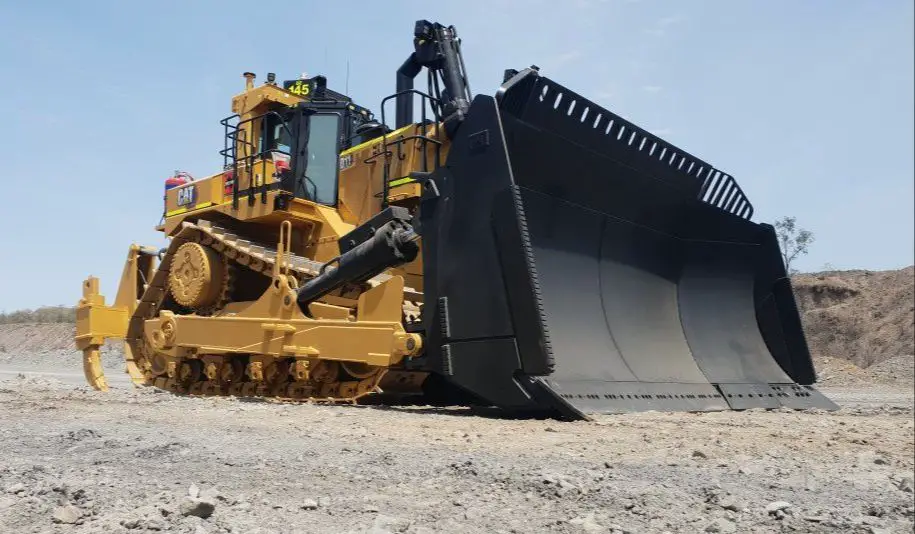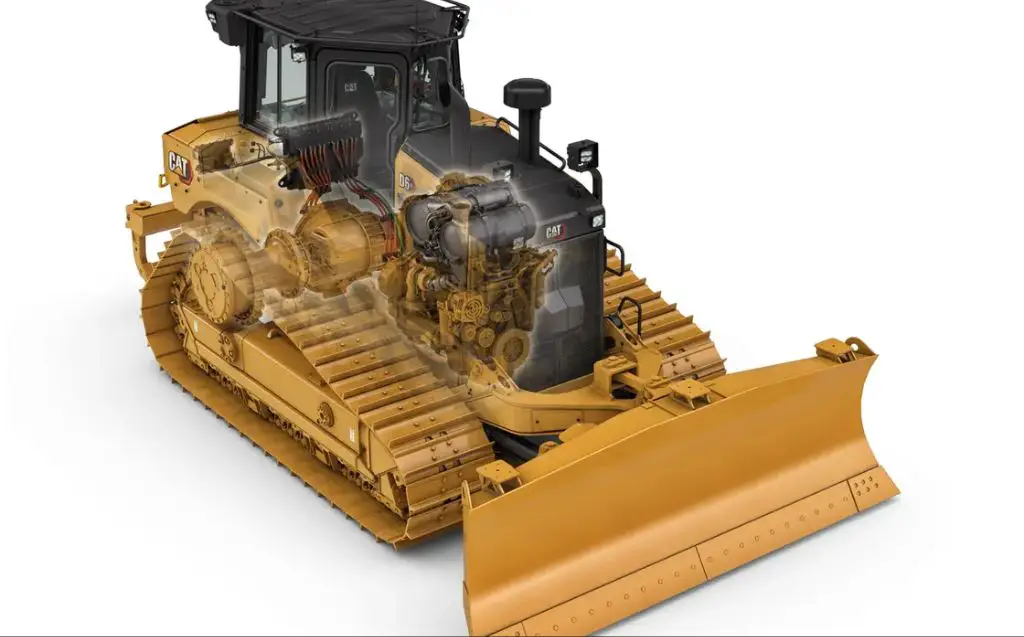Introduction to Caterpillar Dozers
Caterpillar Inc., often shortened to CAT, is an American corporation that designs, develops, engineers, manufactures, markets, and sells machinery, engines, financial products, and insurance to customers around the globe. Caterpillar has been headquartered in Illinois since 1925 and has a rich history producing heavy construction and mining equipment.
Caterpillar began producing track-type tractors, later nicknamed “dozers”, in 1925 with the introduction of the model Sixty. This was the first Caterpillar machine designed specifically for the difficult task of dozing, or moving dirt and rock with a dozer blade. Over the years, Caterpillar has continued to innovate and expand their dozer product line. Some of their most iconic dozer models include the D2, D4, D6, D7, D8, D9, and D10.
Today, Caterpillar offers a wide range of dozer models and sizes to suit customer needs across industries like construction, mining, forestry, waste, and agriculture. Their current lineup includes small, medium, large, and extra large track-type tractors with operating weights from 8 tons up to over 100 tons. With over 95 years of experience building dozers, Caterpillar has cemented itself as an industry leader known for durability, reliability, and productivity.
The D12 Dozer Model

The D12 dozer model from Caterpillar was first introduced in 1955 as a large track-type tractor designed for heavy-duty applications like mining and construction. It quickly became one of Caterpillar’s most popular and well-recognized dozer models.
Some key specs of the D12 as per Caterpillar (Caterpillar D12 Specs):
- Operating weight of 179,000 lb (81,200 kg)
- Blade capacity of 44.1 yd3 (33.7 m3)
- Engine power of 850 hp (630 kW)
- Fuel capacity of 463 gal (1,752 L)
The size and power of the D12 makes it well-suited for heavy construction work like land clearing, mining, road building, and landfill operations. It has excellent pushing power to move large amounts of material. Operators appreciate the D12’s smooth power delivery and ease of control.
Over the decades, Caterpillar has continued to update and improve the D12 with new technology and features while retaining its core strength and reliability. It remains a flagship dozer model even 60+ years after its initial launch.
D12 Design and Engineering
The D12 dozer represents the pinnacle of Caterpillar’s engineering and design capabilities. Caterpillar employs thousands of engineers across the globe focused on improving equipment performance and optimizing productivity for operators.
According to Caterpillar’s engineering page, product development engineers research emerging technologies and design new machines like the D12 to maximize efficiency. Extensive testing and validation ensures optimal quality and durability.
Several key design elements of the D12 focus on boosting performance. The D12 uses a powerful Caterpillar engine providing significant horsepower and torque. This allows the bulldozer to push more material faster. The undercarriage is engineered for stability, using robust components that withstand tough terrain. The blade incorporates curved end bits to roll material for increased efficiency. The cab is designed for operator comfort, safety, and visibility.
Caterpillar’s engineering philosophy for the D12 dozer focuses on collaborating with customers to build heavy machinery that meets real-world demands. Through innovative design and rigorous testing, the D12 delivers optimal productivity and efficiency.
D12 Power and Performance
The D12 dozer is powered by a Cat C32 ACERT V12 four-stroke diesel engine, providing tremendous power and torque. According to Caterpillar, the D12 boasts 1,350 horsepower at 1,800 RPM, making it the most powerful track-type tractor in their product line.

This massive power plant enables the D12 to exert drawbar pull up to 1,000,000 pounds, allowing it to push through the most challenging terrain with ease. The D12’s pushing capacity is unrivaled, with the ability to move more material per pass than any other dozer on the market.
With 1,350 horsepower on tap, the D12 has the grunt to power through virtually any project. The twin turbocharged diesel engine provides optimal torque output across a wide RPM range, so power delivery remains steady even under heavy loads. According to industry sources, Caterpillar has yet to assign an official D12 designation, but prototypes in testing vastly outperform the D11 in terms of sheer power and productivity.
Operator Comfort and Safety
Caterpillar designed the D12 dozer with the operator’s comfort and safety as key priorities. The spacious cab features an ergonomic seat and controls to reduce fatigue during long shifts. The joystick controls are positioned for easy access while still having great visibility. There is ample legroom and the cab is pressurized and sealed to minimize dust.
The operator has excellent lines of sight from the D12 cab. The sloped hood provides a clear view of the blade and front attachments. The cab’s wide windows and rear-view camera give the operator good awareness of the surroundings. This aids in safely navigating the job site and spotting potential hazards.
Some of the safety features of the D12 include a reinforced cab structure to protect the operator, anti-slip steps and handles, seat belts, and roll-over protection. The machine also has fire suppression capability in case of an engine fire. Additional options like LED lights improve visibility and safety for night work. Overall, Caterpillar has made sure the D12 provides a comfortable and safe working environment for operators.
Maintenance Requirements
Routine maintenance is critical for keeping Cat D12 dozers in optimal working condition. The maintenance schedule provides guidelines for completing routine service at recommended intervals.
The most frequent maintenance tasks on the D12 include daily inspections and walkarounds to check fluid levels, inspect hoses and seals, and look for any leaks or damage. Operators should also grease all points daily as outlined in the operator’s manual (Cat).
Oil and filter changes are due every 250 hours for engine oil and 500 hours for hydraulic oil and filters. The high-efficiency hydraulic filters used on the D12 allow hydraulic oil change intervals to be extended to 1,000 hours when using Cat HYDO Advanced oils (Cat). Fuel filters should be replaced every 500 hours.
Larger maintenance tasks like changing coolant, adjusting track tension, cleaning radiators, and inspecting steering clutches are typically scheduled every 500 hours. Major rebuild intervals vary from 2,000 hours for engine in-frame overhauls to 12,000 hours for powertrain rebuilds (Conequip).
Following the routine maintenance schedule laid out in the D12 operator’s manual is essential for maximizing uptime, performance, and longevity of the machine.
D12 Applications and Industries
The Caterpillar D12 dozer is designed for heavy-duty applications in the mining, construction, and land clearing industries where large amounts of material need to be moved quickly and efficiently.

In surface mining operations, the D12 is well-suited for tasks like overburden removal, coal mining, and reclamation projects. Its high horsepower and large blade capacity allow it to rapidly rip through tough material and move substantial amounts per pass. According to one source, the D12 can move up to 90 cubic yards of material per pass depending on conditions (Caterpillar).
For major earthmoving and construction projects, the D12’s size and power make it an ideal choice. It can cut through hard, compacted soil and effectively manage destumping, land clearing, reservoir construction, and slope finishing jobs. The D12 has also been utilized for large pad construction, road building, tailings dams, and other substantial earthworks.
In addition to surface mining and construction, D12 dozers are commonly used in oil sands mining operations. Their ability to continuously move high volumes of oil sand material during extraction and tailings management has made them indispensable in the Alberta oil sands region.
The D12’s combination of brute strength, efficiency, and durability make it one of Caterpillar’s most capable and popular dozers for the most demanding high-production jobs.
Acquiring a D12 Dozer
The Caterpillar D12 bulldozer is an expensive piece of heavy equipment, with costs ranging from around $1.5 million for a used model up to over $3 million for a brand new machine. There are several options for acquiring a D12 dozer, including purchasing new, purchasing used, or leasing.
Brand new D12 dozers can be purchased directly through Caterpillar dealers. As of 2023, a base model D12 starts around $2.5 million, while more fully outfitted models with extra features and larger blades can cost over $3 million. New machines come with the full Caterpillar factory warranty.
Purchasing a used D12 is a more affordable option, with late model used dozers ranging from $1.5 – $2.2 million. Used machines can be found through dealers as well as at auctions and classified sites like MachineryTrader. Be sure to inspect used machines thoroughly and know the maintenance history when buying used.
Many companies choose to lease D12 dozers rather than purchasing them outright. Leasing provides the use of the machine without the large upfront capital investment. Monthly lease payments typically range from $25,000 – $35,000 for a D12. At the end of the lease term, the dozer can either be purchased outright, leased again, or returned.
Comparing the D12 to Other Models
The Caterpillar D12 is the largest dozer model in Cat’s construction equipment lineup. It stands above smaller Cat dozers like the D6, D7, and D8 models in terms of size, power, and capability.
With its 755 horsepower diesel engine, the D12 significantly outperforms the D11 dozer, which peaks at 630 horsepower. The D12 has over 15% more power than the D11, allowing it to exert more force when moving heavy material. This makes the D12 better suited to the largest earthmoving and mining projects.
Compared to competitive dozers from brands like Komatsu, John Deere, Case, and Liebherr, the D12 maintains Cat’s reputation for power and reliability. The D12’s engine provides best-in-class horsepower. Its components, from the track system to blade controls, employ rugged designs tested across millions of hours in the field.
The D12 continues Caterpillar’s legacy of building the world’s strongest production dozers. No other brand can match the D12’s combination of high horsepower, proven reliability, and technological sophistication. These advantages make the D12 stand out as the premier dozer for heavy duty earthmoving and mining applications.
The Future of the D12 Dozer
The Caterpillar D12 dozer has been an industry leader since its introduction in the late 1980s. While the core design has remained relatively unchanged over the past 30+ years, Caterpillar continuously innovates to improve performance, efficiency, and operator comfort.
Looking ahead, industry experts predict Caterpillar will focus on integrating more technology and automation into the D12 platform. Some possible updates and innovations include:

- Increased connectivity and telematics for remote monitoring and diagnostics.
- Semi-autonomous operation features like auto-steering and grade control.
- Alternative fuel options like electric or hydrogen power.
- Enhanced operator displays with augmented reality.
- Integration of machine learning and artificial intelligence.
The outlook for the D12 remains strong despite volatility in commodity prices. Its reputation for reliability and high productivity ensures continued demand in mining, construction, and other heavy industries. While production volumes may fluctuate year-to-year, the D12 is expected to remain a flagship model in Caterpillar’s dozer lineup well into the future.
Caterpillar dominates the large dozer market and will likely maintain its leading position through incremental improvements to the proven D12 platform. Major updates are not anticipated, rather a commitment to quality, safety, and technological evolution.
